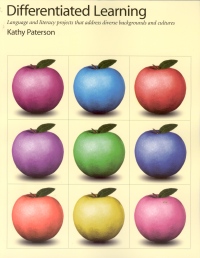| ________________
CM . . .
. Volume XIII Number 2 . . . .September 15, 2006 
 |
Differentiated Learning: Language and Literacy Projects That Address Diverse Backgrounds and
Cultures.
Kathy Paterson.
Markham, ON: Pembroke, 2005.
144 pp., paper, $24.95.
ISBN 1-55138-182-6.
Subject Headings:
Language arts (Elementary).
Special education.
Project method in teaching.
Professional.
Review by Ann Ketcheson.
**** /4 |
| |
|

excerpt:
I hope that the project approach offered in this book will help teachers to realize that diversity in a classroom, rather than being a problem, is an opportunity to enrich the learning of all students and that differentiated instruction is not as difficult as it may seem at first glance.
You'll learn ... to: - manipulate lesson content by aligning classroom tasks with instructional goals, break down objectives into manageable parts, create flexible and effective working groups, encourage students to take part in projects and activities, and tailor expectations to the needs and abilities of students.
Kathy Paterson is a teacher and drama specialist with more than 25 years of classroom experience. She presents 30 different literary projects in this slim book, all aimed at motivating students to work together and learn from one another, regardless of their differences. Paterson suggests that the development of communication skills is essential if teachers are to promote equality and empathy in their classrooms.
The projects are all curriculum-related and are authentic tasks aimed at Kindergarten through Grade 9, making this an excellent supplemental book for a professional library. The book is arranged according to Bloom's taxonomy, and so the first projects deal with knowledge and comprehension and following chapters focus on application, analysis and synthesis. Paterson outlines nine different types of diversities among students: cultural, linguistic, religious, motivational, intellectual, physical, socio-economic, behavioural and gifted. The book offers strategies to help each group.
Within each of Bloom's areas, there are several projects suggested, with a brief overview and explanation of all projects in that section. Two to three pages are dedicated to each individual project, and they include an overview of the project, the materials needed for the project, steps for both teacher and students, ways to diversify the project for various groups, approaches for different grade levels, curriculum connections and, where needed, handouts and questionnaires ready for photocopying.
One great addition is called "quick check" - a last-minute checklist for things which might be obvious but are easily overlooked in the overall planning of a project. For instance, the quick check might include things like "Are there enough for each student and a few extras in case of mistakes?" or "Have I informed the principal there will be visitors in the school?" and so on. The titles of the projects are also intriguing: "People Puzzle Wall Mural", "Fortune Cookie Wishes", "Whose Shoes?", "Silent Island Building" and "Lid-scape Landscapes", to name just a few.
At the end of the book, there are excellent appendices. Appendix A focuses on understanding diversity and how cultural differences may affect classroom behaviour. Appendix B gives some alternatives, especially for holiday-related activities. Appendix C suggests ways of dealing with aboriginal or non-dominant culture students. Appendix D is a multi-language word puzzle. Appendices E, F and G are "New names", "Star theatre" and "Tune time", respectively. Lastly, Appendix H is a list of recommended reading.
Differentiated Learning is an excellent resource for any classroom teacher at any level. The projects are low risk, easy to follow and motivating. Materials needed are readily available at low cost. There is permission to photocopy the various handouts and questionnaires included in the book.
Reading this book and assimilating the variety of projects will be a time-consuming endeavor for a teacher. There is a great deal to think through and absorb and more projects that anyone could possibly do in one school year. On the other hand, the book has imaginative and exciting projects and much of the planning and organizing is already done. It remains for the classroom teacher to choose and modify what will best suit his/her students' needs and interests. The time which will be spent in reading the book will have benefits for years to come!
Highly Recommended.
Ann Ketcheson, a former teacher-librarian and teacher of high school English and French, lives in Ottawa, ON.

To comment
on this title or this review, send mail to cm@umanitoba.ca.
Copyright © the Manitoba Library Association. Reproduction for personal
use is permitted only if this copyright notice is maintained. Any
other reproduction is prohibited without permission.
NEXT REVIEW |
TABLE OF CONTENTS FOR THIS ISSUE
- September 15, 2006.
AUTHORS |
TITLES |
MEDIA REVIEWS |
PROFILES |
BACK ISSUES |
SEARCH |
CMARCHIVE |
HOME |
